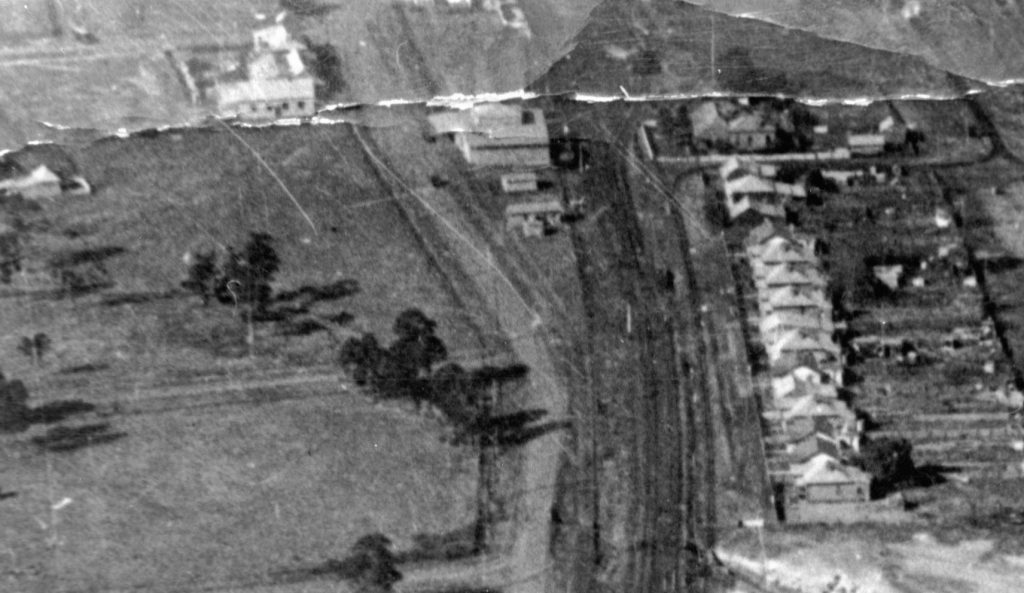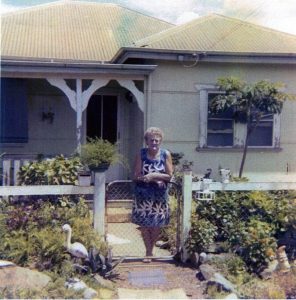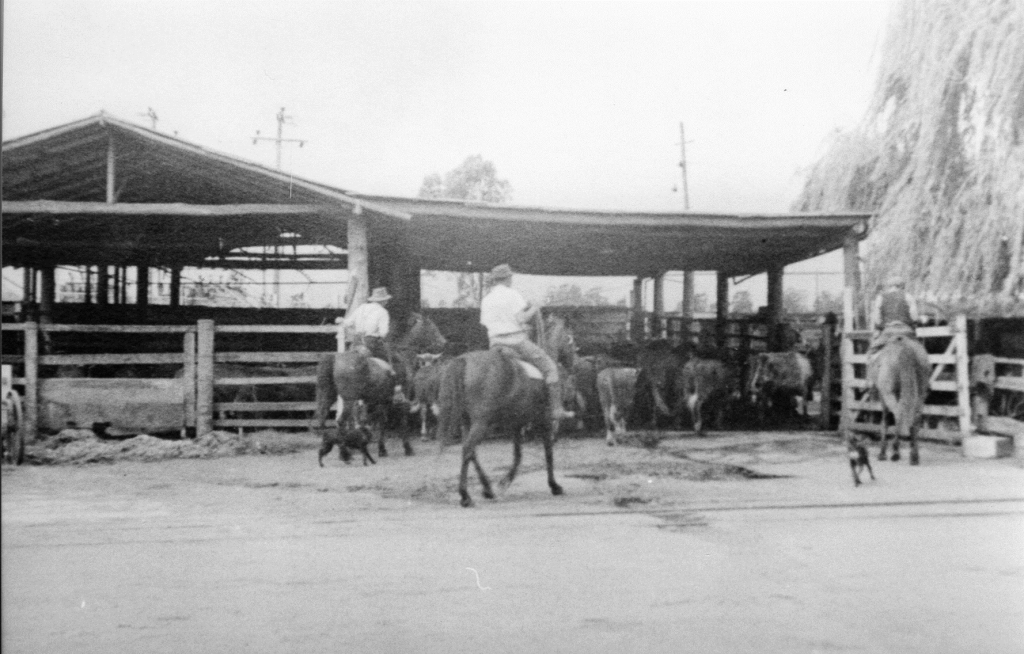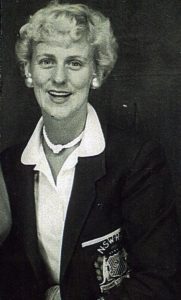by Heather Smith
In 1940 the Meatworks was the life blood of the town of Riverstone and in the words of Helen Liepa, “Butcher’s Row” was the heart.
The avenue was originally named Richard’s Avenue after the founder of Riverstone Meat Company, Ben Richards. However residents gradually adopted the name of Butcher’s Row. The cottages along this avenue were built to house the beef butchers who worked at the Meatworks. In later years it was only necessary to be an employee of the Meatworks to rent one of these houses. Charlie Wheeler is one of the original residents and “ No 23 Butcher’s Row” has been his home for 74 years.
These cottages contain the true history of Riverstone. Following the death of Ben Richards in 1898 the Meatworks changed hands several times over the years and the houses built along the railway line were always under threat of floods. Today the houses face a different and more devastating threat – the demolition by developers of Butcher’s Row. It has been the hard work of the present occupiers led by Carrol Parkes who, in 2010 spear headed the drive to preserve the remaining houses intact. In 1940 Butchers Row was home to 14 families and 27 children and one of those children was Helen Mary Liepa (nee Wheeler).

Helen was born on 29th January 1936 at the doctor’s house in Garfield Road, Riverstone (Sister Barnes’ hospital). She was the middle child and second daughter of Hazel and Bert Wheeler. Bert was descended from Italian migrants, the Puglisi family, who migrated to Australia in 1875 and settled in Randwick. The family fortunes flourished and they became the owners of several picture theatres in Sydney. One of their daughters, Rita, became the first lady film projectionist in Australia. She eventually married Jack Wheeler, the local furniture removalist, who plied his trade in a large horse and wagon. There were nine children from the marriage six girls and three boys. The three boys Jack, Ernie and Bert moved out of the family home in the city and headed to the bush. Jack to St. Marys and Ernie and Bert settled in Riverstone and obtained employment as drovers at Ben Richard’s Meatworks.
Courtships revolved around the many dances and socials held in the district and it was during them that Bert and Hazel met and married. Hazel was the eldest daughter of Gertrude (nee Mills) and Arthur Wells. Arthur emigrated from England as a boy and worked in the freezer at the Meatworks while Gertrude (Gertie) was a house maid at Rouse House. They had four children. Hazel, Margery aka “Minnie”, Charlie and Eric.

Helen has lived in Riverstone and Marsden Park for 75 years and as we sat and talked, the memories of these days came flooding back to her. Wonderful memories that she holds dear to her heart of a community spirit and loving neighbours – each person holding a special place in her memories.
The first house in the row was very tiny with only two bedrooms and was home to Mr and Mrs Boyd and their five children Gary, Sammy, Lawrence, Gloria and Norma. Next was Bert and Hazel’s three bedroom house with front and rear verandahs, lounge room, kitchen, bathroom and laundry with the dog kennels in the back yard. The dogs were working dogs used in the mustering of the large numbers of sheep and cattle which constantly flowed into the Works. Each stockman had his own working dogs trained to respond to his command. Bert’s dogs when Helen was growing up in the 40s were Sox, Biddie and Spider.
Next house moving down the row was Mr and Mrs Bones. He was foreman of the By-products. Beside them was Mrs Baggot and her daughter Phillis. Their house was a grace and favour residence, as Mr Baggot had been killed in the war. Next was Mr and Mrs Peter Steele, (he was a store man), and their two daughters Margaret and May, followed by Mr and Mrs Arthur “Dill” Keegan and their children Fay and Kevin. Mr Keegan was a beef butcher.
The next house was Albert and Alice Davidge. They had three children Donny, Christine and Margery. Albert worked in the Beef House and “moonlighted” as the local SP bookies’ clerk on the weekend. Marie and Sid “Tiger” Locke were next, he worked in the Preserver and their children were Shirley, Sid and Lawrence. Neighbours were Jack and Florrie Strachan and their daughters were Betty and Barbara. Jack worked in the Beef House. Then there was Mr and Mrs Ted Follet, he was boss of the Stockmen. Their children were Allen, Geoffrey, Norma and Anne. It was tradition each year for every family along the Row to order their Christmas poultry from Ted, who would deliver their freshly dressed poultry ready to be cooked for Christmas dinner.
Joe and Eileen Fitzgerald were next, Joe was a renowned horseman in the district and in charge of the Work’s horses and their Clydesdale team. Their children were Ronny and Kate. Their neighbours were George and Ruby Wiggins and children Neville and Iris. George worked on the Mutton Board. Then came Sid and Esme Strachan, he was a Stockman and their children were June, Dennis and Brenda. The last house was occupied by Herb and Nellie Strachan and their nine children, five girls and four boys. Herb was a Stockman. The girls were Jean, Nancy, Marie, Enid, Merle and Joyce and the boys were Sid, ‘Squeaker’, Max and Barry.
Most of the stockmen lived on the Row, as one of their main jobs was the unloading of all the sheep and cattle which came in by train during the night. The stockmen were roused from their beds, usually about 2.00-3.00am by Fred Wells the night watchman. Summer and winter, and in the pitch dark with their team of working dogs they unloaded hundreds of animals and yarded them ready to be moved down to the paddocks in daylight on horseback. Even though sometimes they worked all through the night they were still expected to show up for work the next morning on their stock horses and move the cattle down to the paddocks.

The engine drivers on the steam trains were regulars and knew all the families. They would stop at intervals along the railway line and the fireman would drop shovels full of coal for the kids to pick up and take home for the family stoves.
Helen remembers the special occasions of her childhood. Two or three times a year all the residents of the row were invited to take morning tea with Mr Archibald “Ned” Leeson, the Work’s Manager at his house. This was a grand occasion and everyone went in their Sunday best, Mr Leeson and his two daughters Meg and Nancy welcomed and served each of them with tea and cake. His wife was an invalid and seldom made an appearance.
Every Sunday Vera and Dorothy Abell drove into Butcher’s Row in their horse and sulky to pick up the children and take them to Sunday School at the Church of England church in Elizabeth Street, Riverstone. Weekend outings were always in the family’s horse and sulky. Every second Sunday Bert would harness up their horse and they would drive to St Marys to have lunch with his family. Sometimes they drove to Blacktown on Friday evenings for a special treat of fish and chips. Bert was on the Blacktown Show Committee and annually they went to the Show and also to Castle Hill show. Showtime was always a big occasion. On arrival at the show ground the horses were unharnessed and tethered in the paddock and out would come the picnic baskets and all the families would have their lunch and meet up with old friends.
Helen recalled many childhood memories, Billy Schofield drove the baker’s horse and cart and delivered the fresh bread each morning, he worked for Mr Charlie Fisher. “We children loved it when the ice man, Norm ‘Doughy’ Wallace, came down the road and gave us the broken bits of ice. On Saturday nights every family in the row went en masse to the Olympia picture theatre in Garfield Road. Fourteen families would leave their houses unlocked and head up to the pictures. Nobody’s house was ever broken into, damaged or robbed. On a Saturday morning a lady known only to us as “Old Delia” arrived by train from Sydney with her two suitcases. She went to every house in the row selling her wares. The suitcases contained tea towels small table cloths, pillow cases and socks. Credit was always given to be paid the following Saturday when she would return with new stock in her two suitcases. She was pretty crafty as the credit supplied was the reason for her to return to the houses each Saturday. I don’t know if she visited any other customers in Riverstone.”
Along with all the other kids, Helen attended Riverstone school and trod a well worn path through the railway line fence, across the board walk laid between the railway lines up the platform and on to school. She went on to attend Richmond High school, however as soon as she attained 15 years she left and commenced her first job at St Marys. She caught the early morning bus which ran between the two towns and worked in a factory for 18 months until she suffered an industrial accident and lost parts of two fingers. After that she decided not to go back and immediately obtained a position at the Works.
The beauty of the Works was that it was self sufficient. Everything was made or manufactured on the premises. Helen commenced in the Wrap Room where Ruby Hooper was in charge. Kitt and Mary Attwood also worked in this area sewing the stockinet and hessian bags on a special machine in which the meat for export was sealed. All the identification tags were made in this department as well as the stencilling on both bags and boxes.
She was often called on to work in the Tin Shop where the cans were manufactured and labelled to be packed with bully beef and corned beef. Pat Leslie and Eric Graham also worked in this department. When a department was short staffed, relief staff were often called from other departments to help out. In the Cutting Room she helped to prepare and pack cut meat for contracts with the Army, Navy and Air Force kitchens as well as the two butcher shops in Riverstone. The butchers here were Sid Jarrett and Jock Hilton. Special orders were also packed for high ranking public servants. Often she was called in to help in the Ginger Department to pack the crystallized ginger into jars. The department she liked least was the smallgoods – she could never get the hang of making the sausages.

As a young woman Helen had worked fund raising for the Riverstone Football Club and her energy and popularity was recognized in 1958 by Mr Les Irwin, a local politician and manager of the Bank of NSW in Blacktown. He approached Helen to enter the Miss Riverstone Quest and she entered into the quest with gusto. Many years later in an October, 30 1980 edition, the Riverstone Press produced a nostalgic piece about Helen and her fund raising in 1958.
In 1957-58 a quest was organized by Blacktown Council to raise funds for the Ambulance station at Blacktown as at that time ambulances had to be requisitioned from Parramatta or Richmond stations. In those days, when 35mph was considered a reckless speed over the poor and often unsealed roads of the district, delays in receiving treatment and transport to hospital were considerable and often life threatening. Helen was up to the challenge and through hard work and the unfailing support of the R.S.L Women’s committee and the townspeople in general she raised over 3,000 pounds, a magnificent sum when you consider that the average male wage was around four pounds per week.
During our talk Helen paid tribute to the many local ladies, now gone, who pitched in to help raise the money, Linda Byrnes, Joyce Edwards and Mrs Curry. The article went on to praise Helen and her supporters. Many a pub patron was taken aback by a pretty blonde with a raffle book and a winning smile. They always obliged and were always ‘good sports’. The late Mrs Alice Sullivan and Inaz Davies would cook up to twelve dozen cakes for the cake stalls and the R.S.L chocolate wheel on Saturday mornings outside the picture show. Dances were held in the Masonic Hall and the tulle and taffeta and kid pumps (dancing shoes) were out in force for the ball in the old R.S.L club.
Helen loved ballroom dancing, she attended dances throughout the district and especially loved dances at Riverstone R.S.L sub-branch hall, dancing to the music of Teddy Jones and his band. Ted was the manager of Jericho dairy, one of the Meatworks dairies which was situated where now Windsor Downs is located. Many of the young local boys owed their dancing skill to Helen. The late Johnny Waters, Mattie Johnson and Dessie Cartwright all learnt to dance under Helen’s tuition.
Love blossomed frequently at the Meatworks and it came to Helen when she met a young man John Liepa and on 28th June 1958 they married in St. Pauls Church of England in Elizabeth Street, Riverstone. She was attended by her sister Fay, Dawn Cartwright and June Strachan and her flower girl was Lorraine Wilkins. Groomsmen were Karl Liepa, Dessie Cartwright and Helen’s brother Charlie Wheeler. She and John still reside in Riverstone.
Helen’s love for Riverstone has never wavered, she has lived in the community for 76 years and remains one of the best known personalities of the town and it has been a privilege to have known her for all these years.
